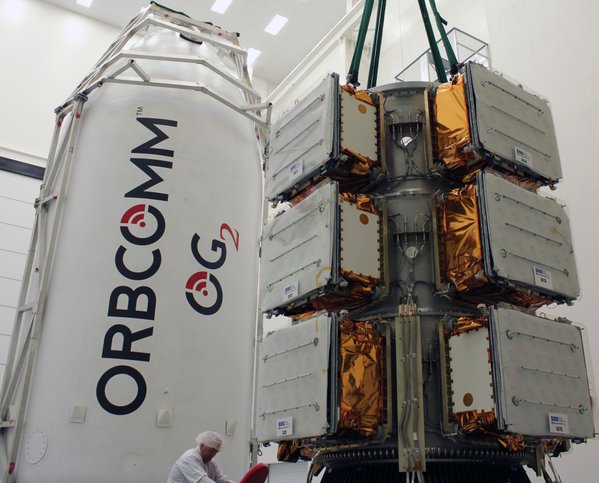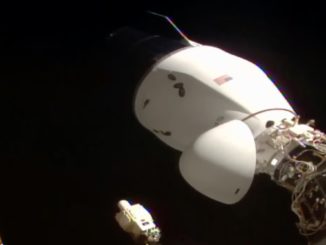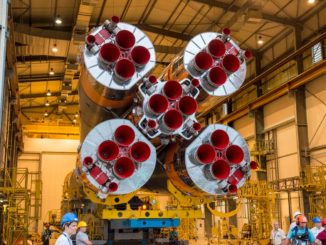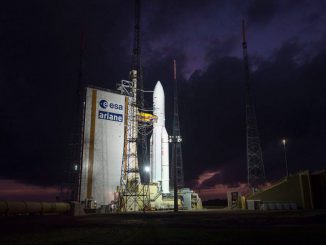
Nearly a decade after Orbcomm raised the money to pay for a second-generation satellite fleet to drastically expand the company’s reach, the $230 million program is finally primed for completion after Monday’s launch of a Falcon 9 rocket from Cape Canaveral.
“It’s exciting,” said Marc Eisenberg, Orbcomm’s CEO, in an interview with Spaceflight Now on Saturday. “It’s been 10 years in the making. We started raising money for this constellation — raising capital — in 2005. The company went public in 2006, did a secondary (financing round) in 2007, and at that point we were fully funded.”
Based in Rochelle, New Jersey, Orbcomm helps businesses track their shipments globally, monitors commercial maritime traffic, and relays short messages through its network of satellites flying in low Earth orbit.
Orbcomm selected Sierra Nevada Corp. and Boeing to build the new second-generation, or OG2, satellites and their communications payloads. Then in 2009, Orbcomm signed a contract to launch the spacecraft one at a time aboard SpaceX’s Falcon 1 rocket.
Plans soon changed when SpaceX decided to abandon the small-class Falcon 1 booster and focus its effort on the larger Falcon 9. Orbcomm renegotiated its SpaceX launch contract to fly the satellites in groups aboard two Falcon 9 rockets, plus a solo flight as a secondary passenger on a SpaceX launch to the International Space Station.
An engine failure on a 2012 Falcon 9 launch led to the rocket’s underperformance, and pre-negotiated guidelines with NASA — the flight’s primary customer — meant the rocket could not relight its second stage engine in a bid to overcome the lower-than-planned orbit. The Orbcomm satellite on that launch — the first of the 18-satellite OG2 order from Sierra Nevada — ended up re-entering the atmosphere a few days later.
Despite the switch to a bigger rocket, SpaceX still honored their Falcon 1 prices, so Orbcomm is paying $42.6 million for two Falcon 9 flights, which usually are sold for about $60 million per launch.
“When we signed with SpaceX, we were their only commercial customer at the time,” Eisenberg said. “We signed up with them on Falcon 1, but they wanted to move to Falcon 9, so we needed to move, and they honored that first deal. We have a long history together, and we’ve done an awful lot for each other.”
SpaceX has grown significantly since 2009, and the California-based company claims it has up to $7 billion of orders in its backlog.
Led by Elon Musk, who made his first fortune from PayPal, SpaceX plans to debut a new version of its Falcon 9 rocket on Sunday’s launch, and the first stage booster will attempt to fly back to Cape Canaveral a few minutes after liftoff in a daring experiment to help make the rocket reusable.
The landing attempt, coupled with Monday’s mission being SpaceX’s return-to-flight launch, have taken up most of the attention on the flight.
Eisenberg is OK with that.
“We’re a B2B (business-to-business) network, so we’re always kind of behind the scenes,” Eisenberg said. “Most people aren’t really sure who Orbcomm is, (but) the cargo that’s coming over on a ship is being monitored by Orbcomm … and the work that’s being done on your pool is being done by an excavator that’s receiving diagnostics through the Orbcomm network.”
Orbcomm has 34 satellites in its operational fleet, including 27 aging first-generation birds, five members of the new generation launched on a Falcon 9 rocket in 2014, and two spacecraft dedicated to maritime tracking applications.
“In terms of being behind the scenes, that’s kind of our sweet spot,” Eisenberg said.
But the rocket’s descent back to Earth is purely experimental — a secondary objective on the launch. A single Merlin engine aboard the Falcon 9’s upper stage will drive the 11 Orbcomm satellites into orbit less than 10 minutes after liftoff and start deploying the payloads just as the first stage is due back at Cape Canaveral.
The 11 satellites are attached to three adapter rings stacked on top of each other inside the Falcon 9 nose cone, which will peel away in two halves about four minutes after liftoff.
Commands to deploy the satellites will engage shortly after the second stage engine switches off, with the 380-pound (172-kilogram) spacecraft released at intervals of about 80 seconds, according to Eisenberg. The entire deployment sequence should be complete about 20 minutes after liftoff.
The Falcon 9’s guidance computer is shooting for a nearly circular orbit with a low point, or perigee, of 385 miles (620 kilometers), a high point, or apogee, of 410 miles (660 kilometers), and an inclination 47 degrees, according to Orbcomm.
The satellites will extend their power-generating solar panel wing, then unfurl antennas and go through a 90-day checkout period before entering service.
Ground controllers will spread out the satellites into Orbcomm’s three orbital planes, and it will take up to a year before the new spacecraft all reach their final positions in the constellation. But Eisenberg said the satellites will be providing service as they drift to their slots.
“There’s no magic when they get there,” Eisenberg said. “It’s not like they get there, and then we turn them on. Every day they get a little closer, and every day the coverage gets a little better.”
Most of Orbcomm’s existing first-generation, or OG1, satellites were launched more than 15 years ago. They have operated years longer than designed, officials said.
Each second-generation satellite carries 48 transmitters and six receivers. That’s compared to six transmitter and one receiver aboard Orbcomm’s first-generation OG1 spacecraft.
The OG2 satellites launched Monday will fill gaps in Orbcomm’s fleet, ensuring more uniform coverage for customers.
“The first thing they’re going to do is drastically speed up service,” Eisenberg said. “The second thing they’re going to do is they’re going to add lots of capacity. One OG2 spacecraft has more capacity the entire OG1 network. The reason you need more spacecraft is for coverage. It’s for timing, it’s not for the capacity, but you can do a lot of things with that capacity.”
Subscribers use the satellites to relay status updates, location pings, commands and other data between companies and far-flung trucks, ships, rail cars, oil and gas infrastructure, weather buoys and research stations.
The satellite operator’s clients include household brands such as Caterpillar, Wal-Mart, Volvo, Tropicana, General Electric. Orbcomm says it focuses on the commercial transportation, heavy equipment, industrial fixed assets, marine, and homeland security industries.
Founded by Orbital Sciences in 1993, Orbcomm Inc. was spun off as an independent company in 2001.
Eisenberg said he was not too concerned with putting Orbcomm’s multimillion-dollar assets on a Falcon 9 rocket that is testing several upgrades for the first time, and coming off a launch failure in June that grounded SpaceX’s booster for six months.
The rocket will operate at higher thrust levels and burn a colder, densified mixture of propellant to increase its performance. The stage separation system and tank structures have also been modified.
“This is certainly an upgraded rocket,” Eisenberg said in an interview Saturday. “There’s also, if you look at the margins and everything, there’s a little bit more redundancy in this rocket as well. I’m feeling pretty good about that. Return-to-flight missions also typically have better success rates than standard missions, but you’re also aware that you need your backup plans just in case, and there’s a reason to buy insurance.”
Email the author.
Follow Stephen Clark on Twitter: @StephenClark1.



